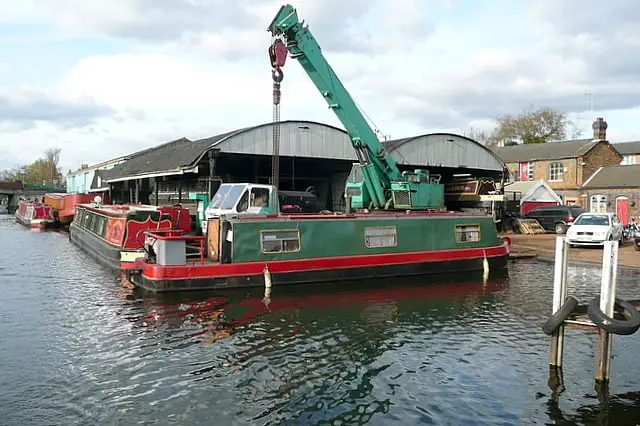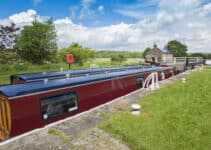Welcome back to Canal Boat UK. As interest in Narrowboating grows, more and more people are looking to buy narrowboats to fulfill their dream of a quiet and tranquil lifestyle 🙂 The problem is, most of them have no idea how to inspect these boats to make sure they don’t buy a lemon 🙂 We are here to help, with some simple tips for buying a second hand narrowboat.
The Used Narrowboat Inspection Checklist
These are the main things you need to check:
Hull
The hull and shell of your narrowboat is the most important part and where most of the value lies. Be sure to inspect this thoroughly so that you know the condition it is in.
For most boat inspections, the boat will be in the water, meaning you cannot inspect the whole hull. In this case, look out for the condition of boat’s hull on the waterline. If it looks worn and in bad condition you can be fairly confident the rest of the hull is too.
A narrowboat hull can last a long time if looked after properly. The problem is, it can also turn into a rust nightmare if not. Blacking a narrowbaot every 2-3 years is a vital part of keeping the rust away. Check with the current boats owner for evidence of how often this boat has been blacked. The only exception is if the boat has been blacked with an epoxy resin instead of the regular bitumen paint. In this case it can last for 5-6 years.
Never buy a boat until you have a full and official survey done by a marine surveyor. Preferably a full inspection in a dry dock. This may seem expensive, but can save a lot of heartache down the road. It also gives you bargaining points to lower the price. Personally, I would never even consider a boat that has had overplating done (when you weld metal plates to fix integrity issues in the hull). If further down the line you find out it was done badly, you will have a nightmare on your hands!!
Engine
The engine is another expensive thing to fix on a canal boat, so be sure to buy one with a solid and reliable unit.
Check for excessive water in the area of the engine bay, suggesting there could be a leak letting water in (for example, the weed hatch).
If you see oil in the engine bay, this could mean there are oil leaks too.
You want to see an engine bay that looks well looked after and clean. However, look out for freshly painted engines as this could have been done to hide rust.
Ask the owner to start the engine. Are there excessive vibrations and/ or rattles coming from the engine? Squeaks could indicate a problem with drive belts. Are there any rev spikes when the engine is idling? All these things could indicate possible problems.
Ask the owner for any receipts regarding previous servicing and repairs done to the boat’s engine and running gear.
Electrics
Electrics are the third part in this trifecta of expensive things to fix on a boat, especially now that solar power is common on canal boats these days.
Firstly, inspect the wiring and condition of the electric system on the boat. Do they seem well maintained, and all wiring routed with care? If the owner has done his or her own renovations to the interior, this is the first thing to check! The last thing you want is a spider’s web of wires to deal with!!
Then think about the specification of the electrics on board. This could greatly affect how much you might need to spend on it in the future.
-Are there at least 3 leisure batteries and a starter battery?
-Does it have a good battery management system? This would mean you can vary the voltages going to your batteries and prevent overcharging. Different batteries may require different voltages, so this is important and makes the system easier to upgrade with new batteries.
-Is there a good invertor on board? A good branded (beware generic Chinese brands) and decently sized invertor will help you get mains power efficiently on your boat.
-Chat to the owner about the type of batteries used and their age. Ask how long they can last when not hooked up to shoreline power? Does this seem enough for your intended use? If not, you may have to invest!
-At the time of writing, solar power is getting expensive, so if it is already onboard and in good working order it could save you money. Just be sure the capacity is enough for your needs.
Bilges
Checking the condition of the boats bilges could also give you an indication about how well it has been cared for. Dirty bilges could indicate neglect. After all, flooded bilges could mean a flooded boat, so most good owners will keep them well maintained. Oily bilges could point to ongoing oil leaks and would warrant further investigation.
Interior
If all of the above are looking good, then you can start considering the interior of the boat.
Damp can play havoc to the inside of a narrowboat, so watch out for signs of an excessively damp interior. If the interior has a strong musty smell, this probably means damp is an issue for this interior. To back this up, check for rotting woodwork within the boat.
Is it a professional or homemade interior fit-out? A professional one is easier to verify and have confidence it will last. Some homemade fit-outs can turn out to be botched and start to break down and require repair faster.
Interior Condition is an Insight into the Owner!
Get a feeling for how cared for the interior fit-out of the boat is. Does it show signs of neglect or is it well cared for? In many cases, the condition of the interior fit-out will link directly to the care taken to look after the engine (one of the more expensive parts of a boat). Put simply, if the interior is neglected the engine probably has been neglected too 🙂 And probably the hull if you are really unlucky!!
However, don’t get sucked into a beautiful-looking interior! Damp is the first thing to check, then admire the interior details later 🙂
General Tips when inspecting Used Narrowboats!
Beware the holiday boats!
A holiday canal boat and a live-aboard boat are totally different beasts, and you need to be aware of this. A holiday hire boat is often only used in the summer months and only for a week or two at a time. The electrics required for this are very different from that needed when you want to live aboard year round.
It is much colder and darker in the British winters, so if you want to live aboard make sure your new boats electrics can cope with this. You don’t want to be the one doing those first stress tests in the freezing cold 🙂
Priorities
A lot of new narrowboat buyers value a used boat far too much on the interior and how it looks. A lot will spend a long time going over the interior fit-out and deciding if they like the layout. Often, these same people will only take a quick glance in the engine bay.
Actually, it is pretty easy to change the interior of a boat and make it exactly how you want after buying the boat. This is relatively cheap and easy in the grand scheme of things. Interior quality can easily be seen and factored into the price you are willing to pay.
However, for many people the engine and electrics are the ticking time bomb that could end up costing them a lot more. The engine and electrics are by far the most expensive items to remedy and fix on any narrowboat, these are the things you should prioritise. Especially those with lower budgets, you should focus on getting a boat with a solid hull, engine and electrics and worry about the interior fit afterwards!
People feel emotionally attached to the interior of a boat due to the fact that they will spend most of their time there. This is why many get their priorities all wrong 🙂 And even those that think they have found their perfect boat interior will still end up changing quite a lot of it over time after actually using it 🙂
Follow this mantra….hull, engine and electrics first interior layout later 🙂
Private Sellers Know More
When buying a used narrowboat you will always get more information on the true nature and quirks of a boat from the owner itself. They have lived with the boat and know all the finer details about the character of the boat and exact condition. A broker, even if they have schooled themselves on the spec sheet, could never give you such a boat specific breakdown of a boat you want to buy.
Often, private sellers are more flexible too. The canal boat community is a friendly and helpful one in nature. I have heard multiple stories of private boat sellers helping the people that they have sold their boats to, especially if they are new to the canals. Anything from riding a few miles down a canal with them to teach them the ropes, to showing basic engine maintenance. You are far more likely to get these extra benefits from a private seller.
If the owner refuses a survey, run away!!
A boat is a big investment and you should never buy one without getting a full survey done first. Some private sellers might seem unwilling to allow this. This is a sure warning sign they have things they wish to hide and would be my signal to run away from the deal as soon as humanly possible 🙂
If you are new…
The problem for new narrowboaters is that they lack confidence in themselves. It is perfectly natural when you don’t know much on a subject to let the more experienced person (in this case the boat owner) take the lead. You could allow serious problems to be glossed over if you are not careful.
Of course, I would recommend doing your own research. Educating yourself through the many resources on the internet or even buying books to guide you through the world of narrowboats.
Even better, see if you can make friends with an experienced boater. If they would be willing to accompany you on some boat inspections, you would know what to look for in no time.
Check previous ownership
Weirdly, boats in the UK don’t have a title to tell you the owners. This makes it harder for you to check. The best thing you can do is to ask the current owner for a bill of sale to make sure they are the official owners of the boat.
You also want to do a credit check to make sure the boat doesn’t have any outstanding finance against it. Something car owners often do, but for some reason boat owners always forget about 🙂
Even if you are buying from a broker, they often don’t do credit checks. Most will ask the seller to sign a declaration stating there is no outstanding finance and put a disclaimer on their literature to waive any liability on themselves.
Get all the documents
All boats over the age of four years old need a Boat Safety Certificate, so make sure this boat has one. This is on top of any service and blacking history mentioned earlier in the article.
Tell us your experiences!!
Have you bought a narrowboat or canal boat before? What was your experience? How did you check it to make sure it was a good one? You can let us all know in the comments section below. We love hearing from the boating community!!



![What Happened to Cruising The Cut [Narrowboat Youtuber]](https://canalboatuk.com/wp-content/uploads/2022/08/cruising-the-cut-youtube-channel-211x150.png)

Hello Guy’s,
Just read through thoroughly (I hope) and am impressed with the content, resulting in, dare I say a boost in my desire to progress to purchasing my first ‘NarrowBoat’ home. I will of course, continue my ongoing research although I can only afford a £20K vessel it’s wise to continue on the ‘learning journey’.
Many thanks, and hopefully I will have a positive and useful report to submit to you once I’ve found the right boat 🙏😜😷
Regards
Chris Lynch
Hi Chris, thanks for your kind words and good luck with your possible new narrowboat purchase! Trust me, there are a lot of others out there in your position! That’s one of the main reasons to start this site. I recently wrote another article about how much a boat costs http://canalboatuk.com/how-much-is-a-canal-boat/ that article might help you get an idea what you might get for your budget.
Very interesting read.
I was a continuous cruiser in the 80s so am familiar with boats.
63 now & intend to buy a boat for my retirement.
Qualified in electronics & experienced rebuilding engines so know what to look for.
As l will be selling a house to finance a boat, l will have enough money to buy a newer boat with a hull that has been looked after.
I would also avoid a boat with the 6mm overplate.
You can find a boat 15yrs old with a completely sound hull. You can also find a 15yr old boat with an overplated hull.
Was very surprised that 40′-57′ boats built in the 70s or 80s which have been overplated 10-15yrs ago
Have asking prices ranging from 25-45k. Now that valuation is unbelievable.
It wouldn’t take me very long to determine whether a boat has been maintained or neglected.
A survey is a must. But would only proceed with that if after my inspection l was prepared to make a subject to survey offer.
Following satisfactory survey l would have the hull cleaned & epoxy applied.
The only thing that concerns me is the lack of services to determine if the boat has outstanding finance.
Jim
Hi Jim, thanks for your valuable insights and good luck with buying your next boat 🙂
Thank you for this insightful article. My husband and I are experienced boaters, but have not owned a narrow boat yet. It is our next move we are going to be CC once we find the one. I am in charge of researching as many aspects of narrow boat life and ownership, so this is really helpful. My Brother is a CC with a 60ft narrow boat, he has given us a lot of tips and information from toilets to engines and all the bits in-between. It is an exciting and daunting chapter we are heading into but it is more exciting than daunting x
Good luck with your narrowboat journey 🙂